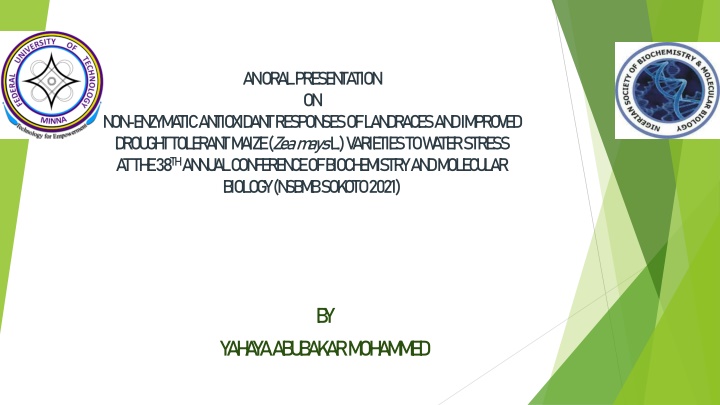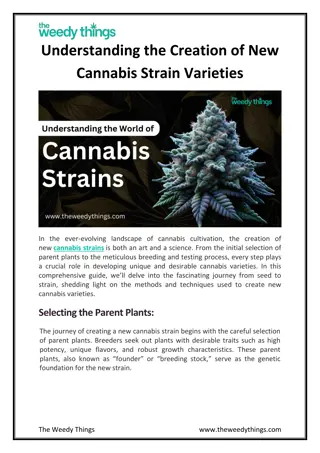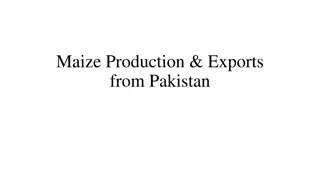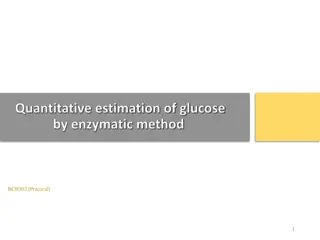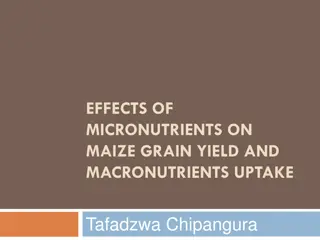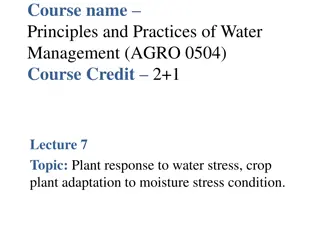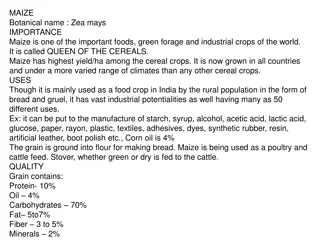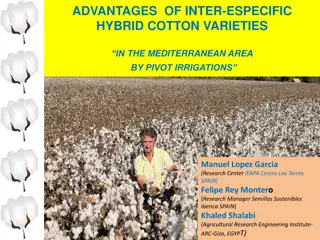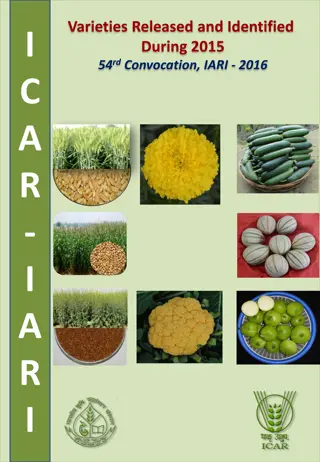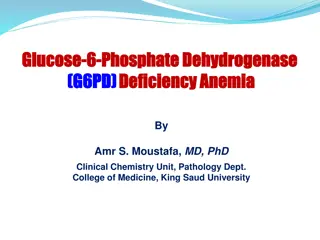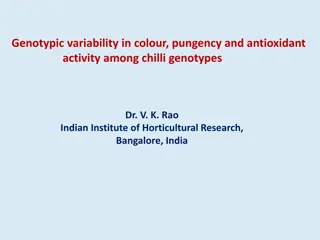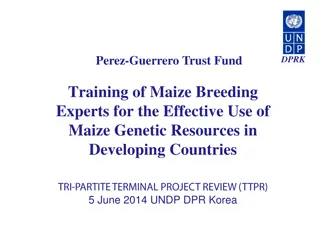Non-enzymatic Antioxidant Responses of Maize Varieties to Water Stress
Introduction of maize as a crucial crop facing challenges from both biotic and abiotic factors like drought, leading to oxidative stress. Non-enzymatic antioxidants play a key role in combating reactive oxygen species (ROS) caused by drought, with crop landraces showing potential in stress adaptation. Addressing the research problem of reduced maize production due to drought, emphasizing the importance of genetic variability in stress-tolerant crop varieties for sustainable development goals.
Download Presentation

Please find below an Image/Link to download the presentation.
The content on the website is provided AS IS for your information and personal use only. It may not be sold, licensed, or shared on other websites without obtaining consent from the author.If you encounter any issues during the download, it is possible that the publisher has removed the file from their server.
You are allowed to download the files provided on this website for personal or commercial use, subject to the condition that they are used lawfully. All files are the property of their respective owners.
The content on the website is provided AS IS for your information and personal use only. It may not be sold, licensed, or shared on other websites without obtaining consent from the author.
E N D
Presentation Transcript
A N OR A L PRE SE N TA TION ON N ON -E N ZYM A TIC A N TIOXID A N T RE SPON SE S OF L A N D R A C E S A N D IM PRO VE D D ROU G H T TOL E R A N T M A IZE (Zea m aysL .) V A R IE TIE S TO W A TE R STRE SS A T TH E 38THA N N U A L C ON FE RE N C E OF B IOC H E M ISTRY A N D M OL E C U L A R B IOL OG Y (N SB M B SOK OTO 2021) B Y YA H A YA A B U B A K A R M OH A M M E D
IN TROD U C TION Maize: a cereal crop with enormous importance that cannot be over emphasized; Food for humans Feeds for livestock Several industrial processes Challenges facing maize production: Biotic factors, e.g., the use of poor quality seeds, and lack of infrastructures, e.t.c. Abiotic factors include; drought, pests, heavy metal toxicity, high salinity, and extremes temperatures e.t. c.
IN TROD U C TION C ON TD Drought is the largest yield reducing abiotic factor (Foley and Jonathon, 2019). Losses of maize yield to drought is about 120 million tones of grain worth 36 million USD (Foley and Jonathon, 2019). Drought causes oxidative stress to plants as a results of increase in the formation of reactive oxygen species (ROS). Excess ROS can damage cellular components such as proteins, metabolic enzymes, DNA, and lipids, ultimately resulting in cell s death (Foyer & Noctor, 2012).
IN TROD U C TION C ON TD Non enzymatic antioxidants: Ascorbic acid, -tocopherol, glutathione, carotenoids, and flavonoids provides an efficient protection against the lethal effects of ROS to plants (Shakeel et al., 2017). The ability to scavenge free radicals and maintain the integrity of the cell membrane under oxidative stress, is correlated to drought tolerance in plants (Shakeel et al., 2017). Identification of plants with tolerance to abiotic stresses, is a prerequisite to marker assisted selective breeding (MASB) of stress resistant crop varieties.
IN TROD U C TION C ON TD This can effectively be achieved through exploiting genetic resources with high potentials for stress adaptive traits such as crop landraces. Crop landraces diverse, and locally adapted to a given set of environmental conditions (Camacho Villa et al., 2005). have historical origin, distinct identity, genetically Availability of stress tolerant varieties of crops in the face of global warming and climate change, can accelerate meeting up with sustainable development goals of eradicating poverty and ensuring global food security.
STATEMENT OF THE RESEARCH PROBLEM Drought has been implicated as one of the major causes of reduced maize production and food insecurity across the globe, particularly in sub-Saharan Africa, where agricultural activities are majorly rain fed (Daryanto et al., 2016). Crop landraces have the potential to play a critical role in climate change adaptations, however, breeders interested in stress tolerant traits tend to concentrate on improved germplasms (Daryanto et al., 2016). The consequence is loss of genetic variability, with only about 5 % of maize germplasm in commercial use (Daryanto et al., 2016)
JUSTIFICATION FOR THE STUDY Unlike high yielding improved varieties, crop landraces are endowed with tremendous genetic variability, and therefore serves as important genetic resources for breeding useful agronomic traits (Daryanto et al., 2016). The recent concern on the biosafety of genetically modified organisms (GMOs) has necessitated the use of safer and effective alternative methods of crop genetic improvement (Charles et al., 2019). Therefore, biochemical parameters obtained in response to water deficit by maize, when tightly linked to gene of interest, can assist breeders in the selection of maize cultivars with high yield and stability under drought conditions (Charles et al., 2019).
AIM AND OBJECTIVES The aim of the study is; To determine the non-enzymatic antioxidant responses of landraces and improved drought tolerant variety of maize to different levels of water stress. The objectives of this study were: To determine the ascorbic acid contents of both varieties in response to water stress To determine the - carotene contents of both varieties in response to water stress To determine the flavonoids contents of both varieties subjected to water stress
AIM AND OBJECTIVES CONTD To determine the lipid Peroxidation values of both varieties in response to water stress in order to ascertain the extent of oxidative damage to cell membranes.
MATERIALS AND METHODS Materials Sample Collection Landraces (TZM 1422 and TZM 219) and improved (Sammaz 40) varieties of maize seed were obtained from Institute of Agricultural Research (IAR) A.B.U. Zaria, and from International Institute for Tropical Agriculture (IITA), Ibadan. Equipment and Apparatus used Screen House, Ceramic Mortar and Pestle, Centrifuge, Hot water bath, Freezer, and UV- spectrophotometer. Chemicals and Reagents All chemicals and reagents were of analytical grades.
MATERIALS AND METHODS CONTD Methods Soil sampling, soil analysis, and soil sterilization Determination of soil water-field capacity Water field capacity of the soil was determined gravimetrically using the water percentage based estimation model of Mbagwu and Mbah (1998). FC= 0.79 (SP) 6.22 (r = 0.972). Treatment and experimental design The experiment was carried out in a completely randomize design (CRD). Samples were divided into 3 groups containing 3 replicates. Treatments were given as T1 (100 % FC), T2 (50 % FC), and T3 (25 % FC).
MATERIALS AND METHODS CONTD Determination of ascorbic acid Ascorbic acid was determined by the indophenols method as described by (AOAC, 1994). Fresh leaves (1 g) from the different levels of water regime treatments at day 1, 15 and 30 were extracted in oxalic acid and titrated against the dye. Amount of ascorbic acid/100g sample = 0.5mg/V1ml x V2/5ml x 2ml/Wt. of sample x100 Determination of - carotene Beta carotene was determined using the acetone extraction method (Tretykov et al., 1990), at day 1, 15 and 30 of the experimental period. 0.5g of fresh samples were extracted with acetone and the absorbance read in spectrophotometer 452.5nm. at 633nm, 644nm and
MATERIALS AND METHODS CONTD Determination lipid peroxidation Lipid peroxidation was determined using thiobarbituric acid reactive substances (TBARS) concentration as described by Carmak and Host, 1991. The concentration of TBARS was calculated using the absorption coefficient, 155Mm-1Cm-1(Carmak and Host, 1991). Determination of flavonoids The flavonoid contents of the extracts were measured as per the Dowd method (1994). An aliquot of 1 ml of extract solution (200 g/ml) were mixed with 0.2 ml of 10% (w/v) AlCl3 solution in methanol, 0.2 mL (1M) potassium acetate and 5.6 ml distilled water The mixture was incubated and absorbance taken at 415 nm. Results were expressed as mg/g of quercetin equivalents per gram (mg QE/g) of fresh extract.
STATISTICAL ANALYSIS ANOVA and Duncan s multiple range test at P < 0.05 were used to analyzed the relationship between the amount of parameters, and increase in the severity of the stress imposed throughout the experimental duration.
RESULTS Table 1: Ascorbic acid contents (mg /100 g FW) of landraces (TZM 1422 and TZM 219) and improved drought tolerant (Sammaz 40) varieties of maize subjected to different levels of water stress. EXPERIMENTAL DURATION (DAYS) VARIETIES TREATMENTS T1 T2 T3 TZM 1422 25.3 0.01c 28.35 0.01c 20.24 0.02c 1 TZM 219 22.66 0.03a 25.56 0.01a 21.60 0.01a Sam 40 21.78 0.10b 21.15 0.02b 21.72 0.03b TZM 1422 24.32 0.04c 34.83 0.07c 21.72 0.06a 15 TZM 219 21.91 0.02b 32.48 0.03a 23.15 0.04b Sam 40 29.47 0.03a 35.94 0.02b 22.17 0.03c TZM 1422 35.62 0.02b 48.65 0.03b 36.96 0.02b 30 TZM 219 36.84 0.08c 50.32 0.05c 33.51 0.04c Sam 40 34.40 0.03a 45.94 0.02a 38.17 0.03a Values are presented in means standard error of three replicates. Values with the same superscript alphabets on the same column are not significantly different at p> 0.05 Key: T1= 100% WC, T2= 50% WC, T3= 25% WC
RESULTS CONTD Table 2: -carotene contents (mg /100g FW) of landraces (TZM 1422 and TZM 219) and improved drought tolerant (Sam 40) variety of maize subjected to different levels of water stress. EXPERIMENTAL DURATION (DAYS) VARIETIES TREATMENTS T1 T2 T3 TZM 1422 TZM 219 Sam 40 0.25 0.00a 0.31 0.00b 0.34 0.03c 0.27 0.01a 0.33 0.01b 0.36 0.02c 0.26 0.01a 0.32 0.01b 0.35 0.02c 1 TZM 1422 TZM 219 Sam 40 0.26 0.01a 0.48 0.01c 0.28 0.04b 0.49 0.04b 0.64 0.06c 0.39 0.02a 0.79 0.06b 0.86 0.01c 0.65 0.02a 15 TZM 1422 TZM 219 Sam 40 0.75 0.02b 0.83 0.03c 0.67 0.08a 0.65 0.05b 0.70 0.03c 0.52 0.02a 0.49 0.01b 0.54 0.04c 0.43 0.01a 30 Values are presented in means standard error of three replicates. Values with the same superscript alphabets on the same column are not significantly different at p> 0.05. Key: T1= 100% WC, T2= 50% WC, T3= 25% WC
RESULTS CONTD Table 3: Flavonoids contents (mgQE/g FW) of landraces (TZM 1422 and TZM 219) and improved drought tolerant (Sam 40) varieties of maize subjected to different levels of water stress. EXPERIMENTAL DURATION (DAYS) VARIETIES TREATMENTS T1 T2 T3 TZM 1422 43.67 0.33b 43.66 0.33 b 43.65 0.32 b 1 TZM 219 42.00 0.58b 42.05 0.58 b 42.02 0.58 b Sam 40 33.00 0.58a 33.03 0.57 a 33.07 0.58 a TZM 1422 46.33 0.67c 50.33 0.88c 54.67 0.67c 15 TZM 219 44.33 0.33b 46.00 0.58b 48.33 0.67b Sam 40 35.00 0.58a 37.67 0.33a 44.00 1.15a TZM 1422 42.67 0.33b 47.67 0.33c 52.00 1.15c 30 TZM 219 43.00 0.58b 41.00 0.58b 46.00 0.58b Sam 40 33.00 0.58a 37.33 0.88a 41.67 1.20a Values are presented in means standard error of three replicates. Values with the same superscript alphabets on the same column are not significantly different at p> 0.05. Key: T1= 100% WC, T2= 50% WC, T3= 25% WC
RESULTS CONTD Table 4: Lipid peroxidation values (nmol/g fw) of landraces (TZM 1422 and TZM 219) and improved drought tolerant (Sam 40) varieties of maize subjected to different levels of water stress EXPERIMENTAL DURATION (DAYS) VARIETIES TREATMENT T1 T2 T3 TZM 1422 TZM 219 Sam 40 1.15 0.01b 1.73 0.00c 0.90 0.00a 1.15 0.01 b 1.72 0.01 c 0.91 0.01 a 1.16 0.02 b 1.73 0.01 c 0.90 0.01 a 1 TZM 1422 TZM 219 Sam 40 1.79 0.01b 1.93 0.08c 0.98 0.04a 1.92 0.01b 2.17 0.00c 1.89 0.03 b 2.02 0.07a 2.28 0.06b 3.23 0.04c 15 TZM 1422 TZM 219 Sam 40 1.38 0.03a 2.95 0.01c 1.58 0.01b 2.35 0.01a 2.64 0.00b 3.98 0.01c 2.73 0.01b 1.94 0.04a 4.05 0.01c 30 Values are presented in means standard error of three replicates. Values with the same superscript alphabets on the same column are not significantly different at p> 0.05. Key: T1= 100% WC, T2= 50% WC, T3= 25% WC
CONCLUSION In conclusion, this study shows that the landraces have higher contents of ascorbic acid, -carotene, flavonoids, and low value of lipid peroxidation in response to different levels of water stress. The higher contents of these metabolites is an indication of good antioxidant activity, while the lower lipid peroxidation value is a reflection of good membrane integrity in the face of oxidative stress.
